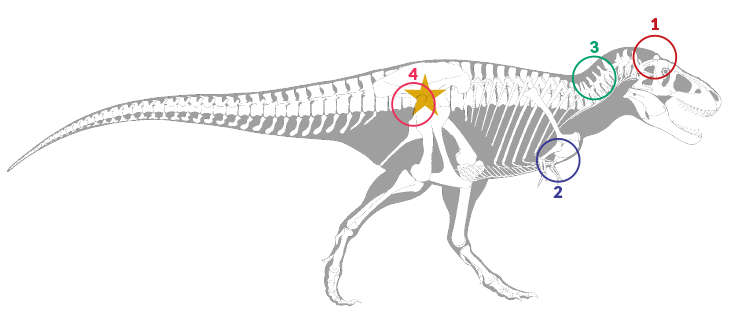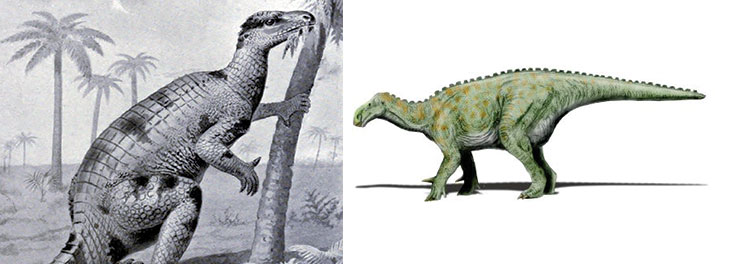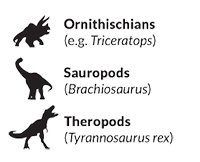Defining a dinosaur is now far harder
New fossils are making it a challenge to know what links them — and separates dinos from others

New fossil finds have pushed aside old views of dinosaurs, like the 1853 beast in Crystal Palace Park in London, England, seen here in the background of this illustration.
NICOLLE RAGER FULLER
“There’s a very faint dimple here,” Sterling Nesbitt says. He holds a palm-sized fossil up to the light. The fossil is a pelvic bone. It belonged to a creature called Teleocrater rhadinus. The slender, 2 meter (6 foot) long reptile ran on all fours and lived 245 million years ago. That’s about 10 million to 15 million years before scientists think dinosaurs first appeared.
Nesbitt is a paleontologist at Virginia Tech in Blacksburg. He tilts the bone toward the overhead light. That illuminates a small depression in the fossil. The dent is about the size of a thumbprint. It marks the place where the leg bone fit into the pelvis. In a true dino, there would be a complete hole in this hip socket, not just a depression. The dimple is like a waving red flag: Nope, not a dinosaur.
The hole in the hip socket probably helped dinosaurs position their legs beneath their bodies. Without it, their legs would have splayed to the sides like a crocodile. Until recently, that hole was among a handful of telltale features — physical traits — used to identify a dino.
Another no-fail trait was a particular depression at the top of the skull. Until, that is, Teleocrater mucked things up. The creature lived before dinos. But it had the “dinosaur” skull depression.

The list of “definitely a dinosaur” features was once quite long. Over the past few decades it has been shrinking. That’s thanks to new discoveries of close dino relatives such as Teleocrater. An April 2017 report of Teleocrater’s skull depression knocked yet another tell-tale trait off the list.
Today, only one feature is still unique to Dinosauria. That’s the great and diverse group of animals we know as dinosaurs. They inhabited Earth for about 165 million years. Then, some mix of asteroid impact and volcanic eruptions wiped out all dinos except birds.
“I often get asked ‘what defines a dinosaur,’” notes Randall Irmis. He’s a paleontologist at the Natural History Museum of Utah in Salt Lake City. Ten to 15 years ago, scientists would list perhaps half a dozen features, he says. “The only one to still talk about is having a complete hole in the hip socket.”
Recently, scientists have dug up lots of new info about dinosauromorphs (Dy-no-SOR-oh-morfs). That’s a group that includes dinosaurs and dino-like creatures that lived right before and along with early dinosaurs. New discoveries are now calling some of those dino-diagnostic features into question. And that has been shaking up long-standing ideas about what the dino family tree should look like.
Yesterday’s diagnostics
Today, only one fossil feature can be attributed solely to members of Dinosauria. That is a complete hole in the hip socket of a fossil.
Several others, including the four below, are no longer surefire dinosaur signs:

1. Until Teleocrater came along, only dinosaurs were known to have a deep depression at the top of the skull. This was an attachment site for some jaw muscles probably related to bite strength.
2. Dinosaurs and some other dinosauromorphs such as Silesaurus opolensis have an enlarged crest on the upper arm bone where muscles attached.
3. Along with dinosaurs, the dinosauromorphs S. opolensis and Asilisaurus kongwe may have had epipophyses. These are bony projections at the back of the neck vertebrae.
4. An extra (fourth) muscle attachment site, called a trochanter, at the point on the femur that meets the hip is also found in the dinosauromorph Marasuchus lilloensis.
Shared traits
In 1841, British paleontologist Sir Richard Owen coined the term “dinosaur.” Owen was thinking about fossil remains from three giants. There was a carnivore named Megalosaurus. There was the plant-eating Iguanodon. And then there was the heavily armored Hylaeosaurus. These animals shared several important features with one another but not other animals, he showed. (In particular, he noted, the creatures’ giant legs were upright and tucked beneath their bodies. Plus, each of the animals had five vertebrae fused together and welded to the pelvis.)
Owen decided the animals should be classed together as their own biological group, or taxon. He named it “Dinosauria.” That roughly translates to “fearfully great lizards.”
Stephen Brusatte is a paleontologist at the University of Edinburgh in Scotland. Back in Owen’s day, he says, it was a bit easier to spot similarities between fossils. Why? “There were so few dinosaurs,” he notes. The more fossils you find, he points out, the harder it can be to know which are most closely related. “With every new discovery, you get a different view of what features define a dinosaur,” he notes. “It’s nowhere near as clear-cut as it used to be.”
Dino survivors
The largest extinction of species on Earth is known as the “Great Dying.” It happened about 252 million years ago. That was at the end of the Permian Period. About 96 percent of marine species and 70 percent of land species died out.
The period that followed was the Triassic. It spanned from 252 million to 201 million years ago. During that time, new reptilian species emerged and flourished. This was the age of early dinosauromorphs and crocodylians. (Those last are the ancestors of crocodiles.) And, of course, there were the true dinosaurs themselves. No one knows exactly when dinos arose. Scientists suspect it was likely some 230 million years ago.
For tens of millions of years, dinos lived beside numerous other reptile types. But at the end of the Triassic, dramatic climate change helped trigger another mass extinction. Dinosaurs somehow survived. They went on to dominate the planet during the Jurassic Period.
Paleontologists once assumed the dinos were somehow superior. Some physical traits, the thinking went, helped them outcompete other reptiles. “But that’s not borne out by new dinosaur relatives,” Nesbitt says. Dinosaurs were quite similar to dinosauromorphs, researchers found. The new trove of dinosauromorph fossils unveils a repeating pattern of parallel evolution. (That’s when similar features evolve independently in two different lines of organisms.) Dinos and other dinosauromorphs developed features such as lengthening legs or having legs directly under the body. In short, Nesbitt says, dinos “are not doing anything different than their closest relatives.”
As a result, many paleontologists now suspect there’s another reason for dinos’ rapid expansion in the Jurassic. The mass extinction at the end of the Triassic left open holes in their ecosystem. These are known as “ecological niches.” Maybe a species that ate fish went extinct. Now that fish-eating role would be available to other species. Dinos might have been taken advantage of such opportunities. This could have let them diversify and flourish.
But that doesn’t explain why dinos survived the mass extinction at the end of the Triassic. What made them different from non-dino dinosauromorphs(and most of the crocodylians), which out? For now, no one knows.
Maybe dinosaurs had anatomical traits that helped them survive, suggests Max Langer. He’s a paleontologist at the University of São Paulo in Brazil. If true, he says, “We don’t know what those features were.”



Uprooting the family tree
To identify the animal that left behind a fossil, paleontologists pore over its bones. They note every one of their bumps, grooves and holes. They might measure the length of the leg’s tibia bone. Or they may count the digits on a forelimb. Before powerful computers were available, scientists would note which species shared bumps and grooves on their bones. They would then use these traits to group those species into evolutionary trees. (These are like a family tree, only linking species instead of individual people.) And they assessed whether those traits (also called characters) were inherited from a common ancestor, or were being passed along for the first time to their descendants.
Langer now calls that approach old-fashioned. Today, scientists use computer algorithms (or problem-solving rules) to help build elaborate evolutionary trees. A fossil’s traits still are the raw data used to create those trees. And the analyses of what order they should fall into will be only as good as those data. Different researchers may focus on different features. They may also interpret the fossils differently. Those issues hit home among dino researchers last year. That’s when a team proposed a fundamental reordering of the dinosaur family tree.
For some 130 years, the basic structure of that family tree had changed little. Dinosaurs were split into two main lines, based on the shape of their hips. Both lines had the hole in the hip socket. That’s still considered unique to all dinosaurs.
One line was known as the ornithischians (Or-nih-THISH-ee-uns). That group includes giant plant-eaters, such as the three-horned Triceratops and plate-armored Stegosaurus. A pubis (PU-bis) is one part of the pelvis in vertebrate animals. In ornithischians, the pubis pointed down toward the tail. The pubis bone in the other line of dinosaurs pointed down toward the front. It created a hip shape that was shared by long-necked sauropods such as Brachiosaurus (BRAK-ee-oh-SOR-us). It’s also found in carnivorous theropods, such as Tyrannosaurus rex. Having similar hips, sauropods and theropods were long considered close “sister” groups. Ornithischians, meanwhile, were seen as distant kin.
That changed in March 2017. That’s when three scientists proposed upending that hip-based approach to arranging dinos on the family tree.
Graduate student Matthew Baron and vertebrate paleontologist David Norman were working at the University of Cambridge in England. They were joined by paleobiologist Paul Barrett of the Natural History Museum in London, England. Together they published a paper in Nature. It observed that ornithischians had been somewhat ignored in past analyses. They were a really diverse bunch. Among them wese dinos sporting a spectacular array of frills and armors and horns and crests.
The three researchers decided to see how differently the family tree would look if it was based on the inclusion of many more ornithischians. So the team incorporated some 457 different fossil traits. These came from 74 species of all kinds of dinos and dino relatives.
The new family tree might as well have come from a totally different forest. It shuffled the three big dino groups around. Baron and his coauthors found that the ornithischians had more than 20 features in common with predatory theropods. It now put ornithischians and theropods together into a new group. And it suggested sauropods had split off from their line at an earlier date.
Their paper made a splash. However, many paleontologists were not convinced.
Indeed, Irmis says, one concern was just how much these analyses relied on judgments that might differ from person to person. Which species a study included clearly affected how the tree turned out. Plus, he notes, a slight difference in how one person interprets the structure of each fossil or skeletal trait could add up, trait after trait, leading to a “huge difference.”
Langer, Brusatte and several of their colleagues decided to tackle this problem head on. “When the paper [by Baron’s group] came out, there was this flurry of excitement,” Brusatte recalls. “But a lot of us noticed right away that there wasn’t a huge amount of description about the [characteristic features of the bones].” Some scientists now became concerned that the fossils in the analysis may not have been examined all that well. Perhaps some features had not been described in enough detail. If so, those ignored details might dramatically alter the results.
Langer, Brusatte and the rest of their team traveled around the world to visit the fossils included in the original paper. They reassessed all 457 traits described — in person. The team had been expecting to cast doubt on the new tree. Maybe they’d even debunk it.
But that none of that happened.
Instead, they showed that the old hip-based dino tree from 130 years ago still offered the best fit to the dino dataset used by Baron, Norman and Barrett.
But the original tree wasn’t that much more likely to be correct than the new tree, they found. “This is the thing that really blew us away,” Brusatte says. In fact, the hip-based tree wasn’t even that much better than an older, third tree. It had grouped ornithischians closer to the other herbivores in the family, the long-necked sauropods. This other tree grouped the fierce theropods on a tree limb of their own.
Langer, Brusatte and their coauthors described their new assessment last November in Nature.
Right now, there is “great uncertainty” about the basic structure of the dino family tree, that paper concluded. “It seems that the flood of new discoveries over the past decades has revealed unexpected complexity.”
Adds Brusatte: “We shouldn’t rewrite the textbooks just yet.” He says, “We’ve taken what we thought was a certainty and turned it into a mystery — and a big mystery, at that.”

Twisting tree
The dinosaur family tree has three main branches: herbivorous ornithischians, long-necked sauropods and fierce theropods. Their relationships may be shifting.
Source: M.C. Langer et al/Nature 2017

Based on hip shape, sauropods and theropods were thought to be more closely related to each other than to ornithischians.

A March 2017 analysis of a longer list of ornithischian species concluded that ornithischians and theropods are closely related.

A November 2017 analysis upheld the traditional view but found that other arrangements are almost equally likely —including a view that clusters herbivorous ornithischians and sauropods together.
Catch-22
How the different dino groups relate may seem like needlessly detailed analyses. But Nesbitt argues that it’s not. The evolutionary tree is the framework for scientific discussions of dino evolution, dino origins and what links all dinos. “It makes it difficult to ask questions about how features are evolving if we can’t have some agreed-upon taxonomy,” he adds, meaning traits that characterize particular branches in the family tree.
So without an agreed-upon tree, it’s hard to figure out which traits might have helped dinosaurs survive that mass extinction at the end of the Triassic. Each change to of the tree seems to highlight different features as being particularly important, Langer says. “If you don’t know how the tree is arranged, you can’t say which feature characterizes [dinosaurs].”
In its November 2017 Nature paper, Langer’s team asks researchers to do more of the dull, routine work of characterizing dino fossils. “We proposed that we need more … anatomical descriptions and definition of characters,” Langer says. He admits “it’s boring.” However, he adds, it’s also very important.
Finding Teleocrater
As Nesbitt cradles the Teleocrater pelvic bone, he turns to a tall cabinet of wide, shallow drawers. He slides one open. This drawer is filled with dozens of carefully labeled boxes. Each holds one or more Teleocrater bones. They had been collected during a 2015 expedition in East Africa to Tanzania’s Ruhuhu Basin.
The first known fossils of Teleocrater rhadinus were actually discovered in the 1930s. Those were just a few bits of vertebrae, pelvis and limb bones. And they sat ignored in London’s Natural History Museum for decades.

The Ruhuhu Basin fossils found in 2015 date to between 247 million and 242 million years ago. The site contains an abundant and diverse mix of fossils from Triassic animals. These include relatives of crocodylians and giant-headed amphibians. And there were ancient reptillian relatives of modern mammals, called cynodonts.
Nesbitt worked in the Ruhuhu Basin in 2010. On his 2015 return, he hoped to find more evidence that would help identify the mysterious Teleocrater.
And he hit pay dirt. His team found a bone bed containing at least three Teleocrater individuals. The fossils included a jawbone and part of a skull known as the braincase. The skull was particularly exciting. Based on a host of features, Teleocrater was clearly a nondinosaur. Yet it’s skull had a depression, just like a true dino.
Paleontologists tend to say that finding more fossils from early dinos and their close relatives will be key to better understanding dinosaurs. They thought it was the surest way to fill in the gaps on the family tree and generally tidy it up.
Nesbitt laughs. “Now we have way more fossils,” he says, “and it’s way messier.”







